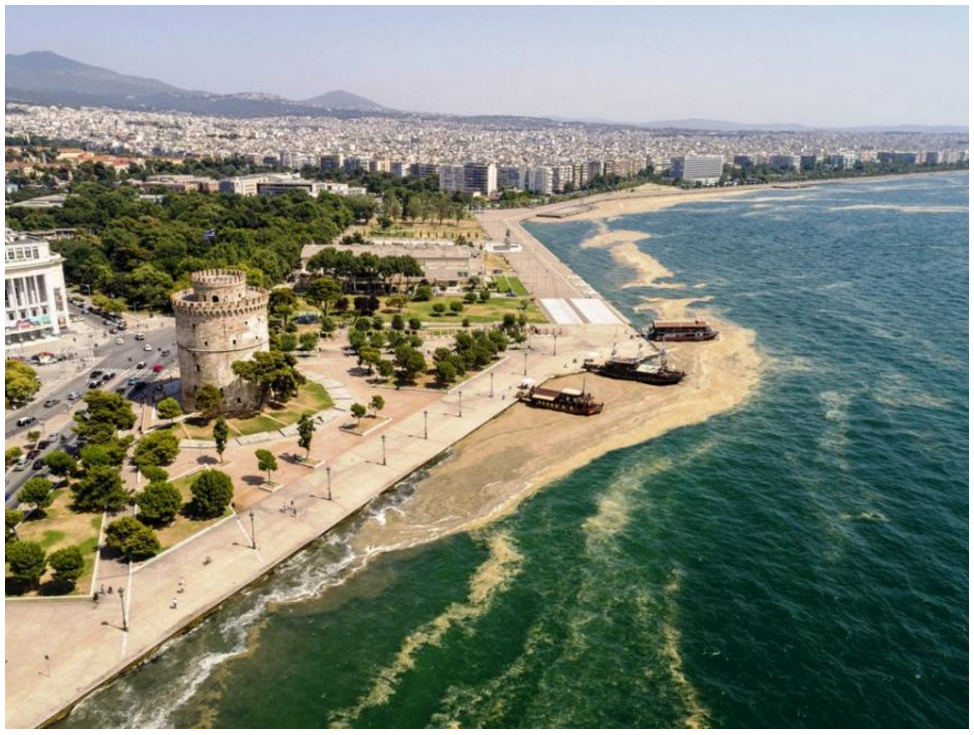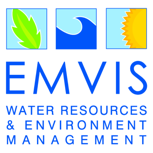Recently the Thermaikos Gulf in Thessaloniki, Greece, experienced one of the worst algae blooms in recent years. On June 26th, 2017, a brown-yellow film of sludge appeared on the surface of the sea. The phenomenon which is known as the “red tide” appears on a regular basis in Thessaloniki (usually spring and autumn) and lasts for about two to three weeks.
However, this time the intensity and the extent of the bloom were unprecedented, and in combination with the high air temperatures, an unpleasant odour was present along the port of Thessaloniki. The phenomenon is attributed to a combination of increased temperatures, the circulation pattern and nutrient overloading from wastewater and the surface run-off of nearby areas featuring intense agricultural activities.

Boats with special equipment tried to limit the extent of the bloom and remove the algae by filtering the surface water, but in the end, it was only the strong wind from north, known to locals as “Vardaris”, which caused the algal bloom to drift away and restored the color of the sea.
Sadly, this is not an isolated story.
HABs have been increasing in size and frequency worldwide, a fact that many experts attribute to global climate change.
An algal bloom is the rapid and uncontrolled growth of an algae population in aquatic environments under favorable conditions, usually recognized by a characteristic water discoloration. The color of the algal bloom is usually greenish, but depending on the photosynthetic pigments in the algal cells, a bloom may also have brown, red, yellow (like in Thessaloniki) or other colors as well.
Algae are chlorophyll containing photosynthetic organisms usually thriving in marine and freshwater environments. These morphologically simple plants form the base of food webs, ranging from unicellular microscopic species to large multicellular forms that may grow up to 50 m in length.
Some algae species produce toxins which can have a broad range of negative impacts to mammals, birds and fish. The most significant threat is caused by cyanobacterial toxins. These toxins threaten not only the sustainability of ecosystems due to the negative impact on aquatic animals and plants, but also directly impact human health, undermining food security and posing significant economic damage to society (drinking water supply, health care, fisheries, aquaculture and tourism). Many cyanobacteria can produce neurotoxic, hepatotoxic, dermatotoxic or other bioactive compounds. Blooms of toxigenic cyanobacteria pose a particular threat if they occur in drinking water sources. The World Health Organization (WHO) has issued an advisory limit for drinking water of 1 μg/L for microcystin-LR, one of the most common cyanobacterial toxins (WHO, 2003).
The cause of HABs…
Algal blooms are usually triggered by high-nutrient conditions in water, mostly by nitrates and phosphorus, which are emitted by agriculture and industry or other human activities. Other factors include increased light intensities and high water temperatures, as well as limited water circulation.
Harmful algal blooms (HABs) are blooms that can cause significant damage to other aquatic organisms, animals, the environment and economies. High biomass blooms can deplete oxygen in the water and block sunlight penetration, preventing the growth of other algae and disrupting food webs. After the death of the algae, the bacteria which decompose them use up even more dissolved oxygen which can kill fish and bottom dwelling organisms.
The human health and ecological impacts of freshwater HAB outbreaks goes beyond the appearance and smell that was so obvious in Thessaloniki and can have serious economic costs. Toxins and taste-and-odor compounds (geosmin and 2-methylisoborneaol or MIB) result in increased treatment costs for drinking water facilities, and algal mats can interfere with reservoir operations, such as drinking water intakes and hydroelectric generation, while off-flavor compounds are a major cause of economic losses for the aquaculture industry.
As an example of the potential magnitude of economic losses, the economic cost of algal blooms (marine and freshwater ecosystems) in Greece, Italy and Spain is estimated to cost over €300 million per year (DG, 2014). Scientific and policy reports show similar trends in freshwater systems around the world (Kudela R.M. et al., 2015; Lopez, 2008). Potential eutrophication-related losses in the United States, primarily due to cyanobacterial blooms, are estimated at up to US $4.6 billion annually; the 1998 season of cyanobacterial blooms in the Lake Tai catchment (China) resulted in estimated economic losses of US $6.5 billion. Annual costs of freshwater algal blooms in Australia were estimated at between US $150-200 million, with similar annual eutrophication costs in the United Kingdom estimated at US$ 150 million and in South Africa at US $250 million.
Space technology currently enables us to use satellite imagery to retrieve various water quality parameters including chlorophyll concentrations and harmful algae bloom indicators. Earth Observation (EO) products can be a valuable tool for monitoring water quality especially for large-scale phenomena like algal blooms. Improved water quality monitoring has multiple benefits within the water management sector and is a key motivation for technological innovation within the space technology sector. For example, SPACE-O is combining advanced EO algorithms with state of the art hydrological and ecological modelling in order to extend the monitoring capabilities. Water managers at reservoirs and lakes will be able to use these innovative data products to produce near-real-time forecasted water quantity and quality data. For example, water managers can take actions to mitigate the sources of algal blooms and water treatment practices can be adapted to optimize efficiency based on incoming raw water quality. Furthermore, water quality monitoring is an invaluable tool for informing water policy. Improved monitoring through technologies developed based on data from space will reveal emergent water quality trends and risks and inform policy enforcement and the development of better suited policies. SPACE-O and innovations from space like it could catalyze improved water management around Thermaikos Gulf, reducing the harmful impact of algal blooms.
References
WHO. (2003). Cyanobacterial toxins: Microcystin-LR in Drinking-water. http://www.who.int/water_sanitation_health/dwq/chemicals/microcystin/en/.
Kudela R.M. et al. (2015). Harmful Algal Blooms. A Scientific Summary for Policy Makers. IOC/UNESCO, Paris (IOC/INF-1320).
Lopez, C. J. (2008). Scientific Assessment of Freshwater Harmful Algal Blooms. . Washington, DC: Interagency Working Group on Harmful Algal Blooms, Hypoxia, and Human Health of the Joint Subcommittee on Ocean Science and Technology.
DG, E. C. (2014). Harmful algal blooms in Europe will increase under climate change . Science for Environment Policy. Environment News Alert Service, edited by SCU, The University of the West of England, Bristol. http://ec.europa.eu/environment/integration/research/newsalert/pdf/385na2_en.pdf.
This blog was written by Evangelos Romas, EMVIS Consultant Engineers.
If you are interested in joining the discussion on the use of Earth Observation for Improved Water Management, visit our discussion group dedicated to the topic at the International Water Association’s IWA Connect. If you are not yet a member of IWA Connect, you can easily join as a network member for free here. Once you are logged-in, you can access the discussion group here.









